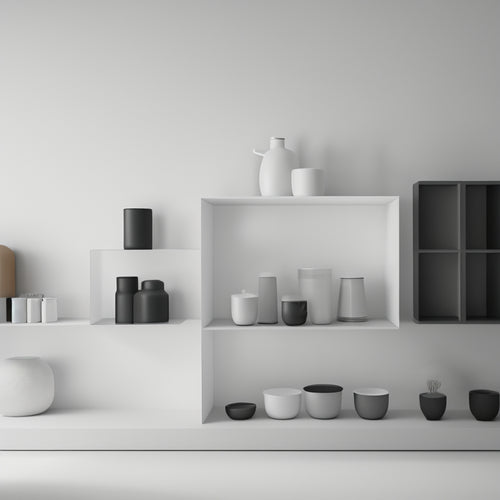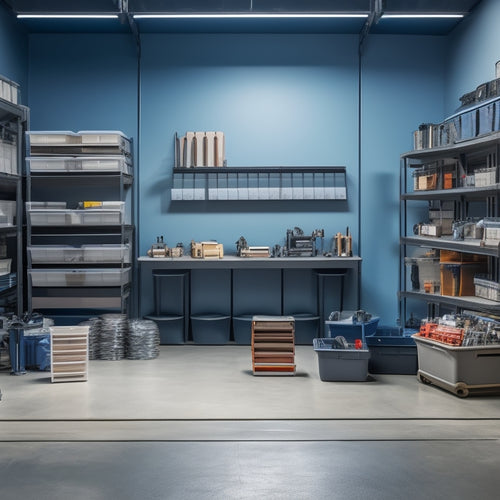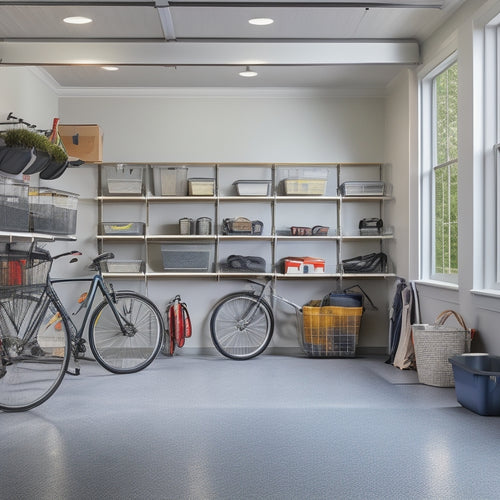
What to Consider When Buying a Tool Workbench
Share
When buying a tool workbench, you'll need to take into account durability and build quality, ensuring a sturdy frame with a high weight capacity and a rust-resistant finish. The work surface size and material must fit your project needs and workshop space, with options like wooden, metal, or composite surfaces each offering unique benefits. Adequate storage and organization are also essential, with customizable drawer layouts and shelf dimensions impacting productivity. Additionally, ergonomic design features like height adjustment and ample legroom can reduce fatigue, while your budget will influence the balance between initial cost and long-term value - and it's worth exploring these factors in more detail to make an informed decision.
Key Takeaways
- Consider a sturdy workbench frame made of steel or heavy-duty aluminum with a powder-coated finish for durability and weather resistance.
- Choose a work surface size and material that suits your project type, workshop space, and maintenance preferences, such as wooden, metal, or composite.
- Evaluate storage capacity and organization features, including customizable drawer layouts, shelf and drawer dimensions, and weight capacity, to ensure efficient tool accessibility.
- Opt for an ergonomic design with height adjustment, spacious surface, ample legroom, and non-slip surface to minimize body strain and discomfort during use.
- Assess the budget and value for money, factoring in the initial cost, long-term durability, maintenance, and upgrade potential to justify your investment.
Durability and Build Quality
You'll want a tool workbench that can withstand the rigors of repeated use and potential mishaps. A sturdy workbench is essential for safety and efficiency in your workspace.
Look for a workbench with a durable frame constructed from high-quality materials, such as steel or heavy-duty aluminum. Make certain the frame is powder-coated or finished with a rust-resistant coating to provide weather resistance.
The workbench's weight capacity is also vital. Consider the maximum weight you'll need to support, including tools, equipment, and materials. A workbench with a high weight capacity will provide peace of mind and prevent accidents.
Check the manufacturer's specifications to verify the workbench can handle the weight you need. A well-built workbench will also feature reinforced legs and a stable base to prevent tipping or wobbling.
Additionally, consider a workbench with adjustable legs to accommodate uneven floors or surfaces. By prioritizing durability and build quality, you'll create a safe and reliable workspace that meets your needs.
Work Surface Size and Material
With a sturdy frame in place, your focus shifts to the work surface, where the bulk of your work will take place. When selecting a work surface, consider the size and material. The ideal work surface size depends on the type of projects you'll be working on and the space available in your workshop. A larger surface provides more room to spread out your tools and materials, but it may be impractical for smaller spaces.
You'll also need to choose from various work surface types, including wood, metal, and composite materials. Wooden surfaces are durable and resistant to scratches, but they require periodic sealing to prevent warping. Metal surfaces are durable and easy to clean, but they can be noisy and may cause tools to slip. Composite surfaces offer a balance of durability and ease of maintenance.
Regardless of the material, make certain the work surface is smooth and even to prevent accidents and injuries. Additionally, consider the maintenance requirements of your chosen work surface, as some may need regular cleaning or sealing to maintain their integrity.
Storage Capacity and Organization
Adequate storage capacity and organization are vital components of a functional tool workbench, as they directly impact your productivity and efficiency.
You'll want to take into account the types of tools you'll be storing and how you can optimize your workbench's storage to guarantee easy tool accessibility. Drawer configurations are an essential aspect of this, as they can greatly affect your workflow. Look for workbenches with customizable drawer layouts that can be customized to your specific needs.
When evaluating storage capacity, think about the size and quantity of your tools, as well as any materials or supplies you'll need to store.
Consider the height and width of the workbench's shelves and drawers, and whether they can accommodate your largest or most frequently used tools. Additionally, consider the weight capacity of the workbench's storage components to confirm they can handle the weight of your tools and materials.
Ergonomic Design and Comfort
Since a tool workbench is typically a workstation where you'll spend a significant amount of time, its ergonomic design and comfort are essential factors to contemplate.
You'll want a workbench that allows you to work efficiently without straining your body. Look for a workbench with a height adjustment feature, which enables you to customize the surface to your ideal working height. This feature is particularly important if you'll be sharing the workbench with others or if you plan to use it for varying tasks that require different stances.
Additionally, consider the user accessibility of the workbench. Confirm that the surface is spacious enough to accommodate your tools and materials comfortably, allowing you to move around the workspace with ease.
A well-designed workbench should also provide ample legroom and clearance to prevent fatigue and discomfort. Pay attention to the material and finish of the workbench, opting for a durable, non-slip surface that can withstand heavy use.
Budget and Value for Money
Tool workbench prices can vary widely, depending on the materials used, size, and features, so it's essential to set a realistic budget before making a purchase.
You'll need to balance your needs with your financial constraints to guarantee you get the best value for your money.
When setting your budget, consider the following factors:
-
Initial cost: The upfront price of the workbench, including any additional features or accessories.
-
Long-term durability: A higher-quality workbench may cost more initially, but it'll last longer and require fewer repairs or replacements.
-
Maintenance and upkeep: Some workbenches may require more frequent cleaning or maintenance, which can add to their overall cost.
- Upgrade potential: Consider whether the workbench can be easily upgraded or modified to meet future needs, reducing the need for costly replacements.
Frequently Asked Questions
Can I Customize the Workbench to Fit My Specific Needs?
You can customize the workbench to fit your specific needs by choosing a model that prioritizes space efficiency, allowing you to maximize storage and workflow, while also considering material durability to guarantee a safe and reliable workspace.
Will the Workbench Be Compatible With My Existing Tools and Accessories?
You'll want to make certain the workbench is compatible with your existing tools and accessories, considering factors like tool mounting systems, accessory integration, and power supply compatibility to confirm seamless integration and safe operation.
Are There Any Specific Safety Features I Should Look For?
As you forge ahead, prioritize safety above all; look for a workbench with top safety ratings, an ergonomic design that reduces strain, and built-in features like anti-slip surfaces and cable management to minimize hazards, ensuring a secure workspace.
Can I Assemble the Workbench Myself, or Do I Need Help?
You'll likely need help assembling a tool workbench, but if you're comfortable with DIY projects, follow assembly tips to guarantee a sturdy build, and consider your workspace efficiency to optimize the layout for maximum productivity.
Are There Any Certifications or Warranties I Should Look For?
As you traverse the tool workbench market, be a hawk eyeing certifications from organizations like UL or ETL, ensuring the product meets rigorous safety standards; also, scrutinize warranty options, like length and coverage, to shield yourself from costly repairs or replacements.
Conclusion
When crafting your ideal workspace, carefully consider each essential component. A durable, dependable workbench forms the foundation, promoting focus and fluidity. Select a surface size that suits your tasks, and prioritize storage that streamlines your workflow. Ergonomic design guarantees comfort, reducing fatigue and frustration. Finally, weigh budget against value, seeking a bench that balances cost with quality. By synchronizing these elements, you'll create a harmonious haven that heightens productivity and precision.
Related Posts
-

Small Shelving Options for Tight Spaces
You're surrounded by tight spaces in your home, and you need clever shelving solutions that optimize storage without ...
-

How to Maximize Storage Space With Parts Storage Bins
To maximize storage space with parts storage bins, start by evaluating your available storage space and examining you...
-

Bin Garage Storage Ideas for Maximizing Space
You can greatly maximize your garage's storage space by utilizing vertical space with ceiling storage bins, stacking ...


